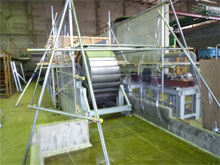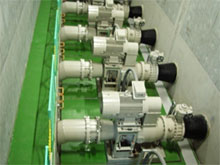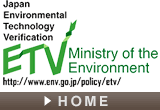Target Technology Fields
Small hydropower generation technology field

Low head overshot water-wheel generation system for use in open channels

Example of control using multiple water-wheel generators
Outline of Technologies
The target technologies are those for small-scale small-output power generation using potential energy produced by the flow of mountain streams, rivers and drainage channels and the head (those of which the output is not more than 30,000 kW). Although the initial cost tends to be higher than that of large-scale hydropower generation, its development potential in Japan is fairly large. Improvement of its payability should help to control global warming.
Examples of Target Technologies
Inventions or innovations relating to water-wheels, generators, step-up gears,
control equipment and electrical equipment and also inventions or innovations
relating to supply and demand of independent operation.
Reference Materials
For users
Small hydropower generation offers a purely domestic
renewable energy without producing CO2 in its process. It can use existing facilities
(water supply and sewerage facilities, sabo dams and irrigation channels among
others) without alteration and its environmental load during the construction
process is small. It is characterized by little power output fluctuation, promising
a stable supply of power day and night all year round.
The ETV Program assists the selection of technologies suitable for the needs
of users by means of disclosing the results of technology verification tests
conducted by third party organizations regarding an effective head, flow volume,
generation output, efficiency, noise and other relevant issues and providing
various types of information required to judge the effectiveness of individual
technologies.
For verification applicants
The ETV Program assists the dissemination and
wider use of effective technologies of verification applicants by means of bringing
out the potential needs of clients through the introduction of the outline of
environmental technologies to general clients to meet their needs to deal with
problems, the disclosure of the results of technology verification tests conducted
by third party organizations and the provision of various types of information
required by users to select technologies.
A questionnaire survey with verification applicants in the past received such
replies as “The number of enquiries about the technology has increased since
verification” and “There have been certain positive effects on sales promotion
and technological development activities”. Another reply concerning the issued
logo was that “The logo has been attached to the product pamphlet, technical
reports, company brochure, and company website”.
 Low head overshot water-wheel generation system for use in open channels
Low head overshot water-wheel generation system for use in open channels Example of control using multiple water-wheel generators
Example of control using multiple water-wheel generators


















